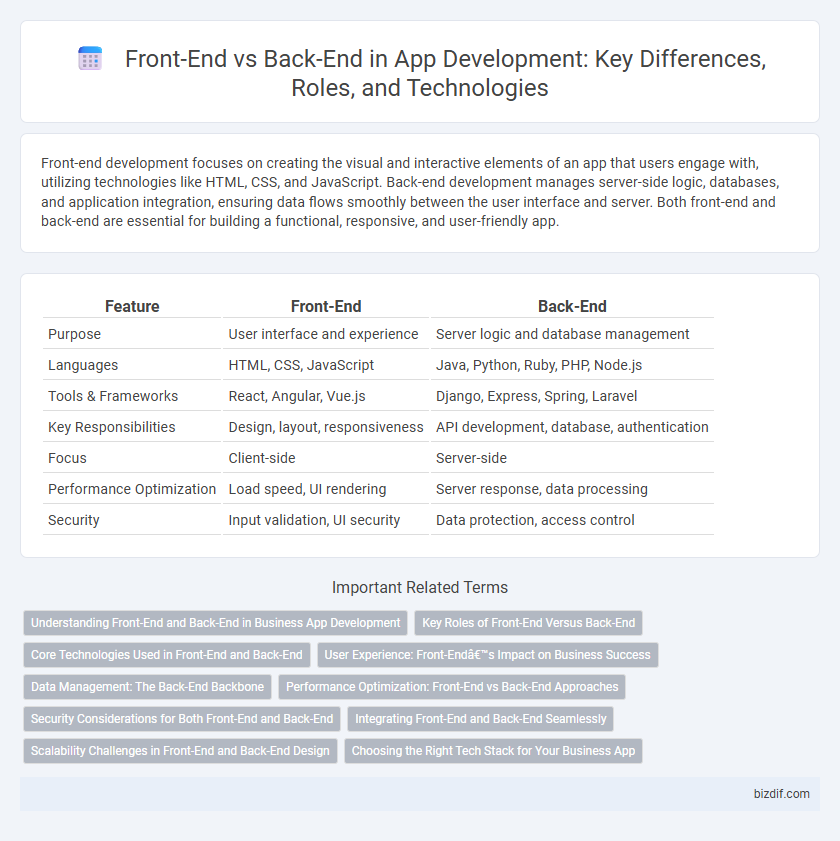Front-end development focuses on creating the visual and interactive elements of an app that users engage with, utilizing technologies like HTML, CSS, and JavaScript. Back-end development manages server-side logic, databases, and application integration, ensuring data flows smoothly between the user interface and server. Both front-end and back-end are essential for building a functional, responsive, and user-friendly app.
Table of Comparison
| Feature | Front-End | Back-End |
|---|---|---|
| Purpose | User interface and experience | Server logic and database management |
| Languages | HTML, CSS, JavaScript | Java, Python, Ruby, PHP, Node.js |
| Tools & Frameworks | React, Angular, Vue.js | Django, Express, Spring, Laravel |
| Key Responsibilities | Design, layout, responsiveness | API development, database, authentication |
| Focus | Client-side | Server-side |
| Performance Optimization | Load speed, UI rendering | Server response, data processing |
| Security | Input validation, UI security | Data protection, access control |
Understanding Front-End and Back-End in Business App Development
Front-end development focuses on creating the user interface and experience, utilizing technologies like HTML, CSS, and JavaScript to ensure responsive and intuitive designs for business applications. Back-end development handles server-side logic, databases, and application integration using languages such as Python, Java, or Node.js, enabling secure data processing and scalable performance. Understanding the synergy between front-end and back-end components is essential for developing efficient, user-friendly business apps that meet functional and operational requirements.
Key Roles of Front-End Versus Back-End
Front-end development involves designing user interfaces, ensuring responsive layouts, and creating interactive experiences primarily using HTML, CSS, and JavaScript frameworks like React or Angular. Back-end development focuses on server-side logic, database management, API creation, and handling authentication protocols utilizing technologies such as Node.js, Python, Ruby on Rails, or Java. Together, front-end and back-end roles coordinate to deliver seamless, efficient applications by managing client-side presentation and server-side functionality.
Core Technologies Used in Front-End and Back-End
Front-end development primarily utilizes HTML, CSS, and JavaScript frameworks like React, Angular, and Vue.js to create responsive and interactive user interfaces. Back-end development relies on server-side languages such as Node.js, Python, Ruby, Java, and PHP, supported by databases like MySQL, MongoDB, and PostgreSQL to manage application logic and data storage. Both front-end and back-end technologies integrate through APIs and web services to deliver seamless software experiences.
User Experience: Front-End’s Impact on Business Success
Front-end development directly shapes the user experience by creating intuitive interfaces and seamless interactions that enhance customer satisfaction and engagement. Fast-loading, responsive designs reduce bounce rates and increase conversion rates, driving overall business growth. Investing in front-end innovation ensures that businesses meet user expectations and gain a competitive advantage in the digital marketplace.
Data Management: The Back-End Backbone
Back-end development serves as the backbone of data management by handling server-side operations, databases, and API integrations that ensure secure data storage, processing, and retrieval. Unlike front-end development, which focuses on user interface and experience, the back-end manages complex business logic, authentication, and real-time data synchronization. Efficient back-end architecture optimizes performance and scalability, enabling seamless interaction between the user interface and underlying data systems.
Performance Optimization: Front-End vs Back-End Approaches
Front-end performance optimization involves reducing load times by minimizing JavaScript execution, optimizing CSS delivery, and employing lazy loading for images and components to enhance user experience. Back-end performance optimization focuses on efficient database queries, server-side caching, and load balancing to handle high traffic and reduce response times. Combining both approaches ensures seamless application performance, balancing client-side responsiveness with robust server processing.
Security Considerations for Both Front-End and Back-End
Front-end security focuses on protecting user data through secure authentication, input validation, and safeguarding against cross-site scripting (XSS) and cross-site request forgery (CSRF) attacks. Back-end security emphasizes securing databases, server environments, and APIs by implementing robust access controls, encryption, and regular security patching to prevent SQL injection and unauthorized data breaches. Both layers require continuous monitoring and adherence to security best practices to ensure comprehensive protection throughout the app development lifecycle.
Integrating Front-End and Back-End Seamlessly
Integrating front-end and back-end seamlessly requires robust API design that ensures efficient data exchange and real-time synchronization between user interfaces and server logic. Employing RESTful services or GraphQL enables smooth communication, while frameworks like React or Angular coupled with Node.js or Django streamline development workflows. Optimizing this integration enhances performance, scalability, and user experience in modern app development.
Scalability Challenges in Front-End and Back-End Design
Scalability challenges in front-end design often involve managing complex user interfaces and ensuring fast load times across diverse devices and network conditions. Back-end scalability issues center on handling increasing volumes of data, concurrent user requests, and maintaining database performance under high traffic loads. Effective app development requires optimizing front-end component rendering and implementing scalable server architectures like microservices and load balancing.
Choosing the Right Tech Stack for Your Business App
Selecting the appropriate tech stack for front-end and back-end development is crucial to ensure your business app delivers optimal performance, scalability, and user experience. Front-end frameworks like React, Angular, or Vue.js offer different benefits in terms of speed, flexibility, and community support, while back-end technologies such as Node.js, Django, or Ruby on Rails provide varying capabilities for server-side processing, database management, and API integration. Aligning your tech stack with your business goals, target audience, and development resources maximizes efficiency and app success.
Front-End vs Back-End Infographic

 bizdif.com
bizdif.com